
Stata Journal
Scope & Guideline
Unveiling groundbreaking research for the academic community.
Introduction
Aims and Scopes
- Statistical Methodology Development:
The journal publishes articles that introduce new statistical methods or improve existing ones, particularly those that can be implemented in Stata. - Application of Stata in Empirical Research:
A significant focus is on demonstrating the practical application of statistical techniques using Stata in various fields such as economics, health research, and social sciences. - User-Centric Tools and Commands:
The journal regularly features new commands and tools developed for Stata, aimed at enhancing user experience and expanding the software's functionality. - Educational Resources for Stata Users:
It provides tutorials, tips, and reviews of educational materials related to Stata, aiding both novice and experienced users in leveraging the software effectively. - Meta-Analysis and Systematic Reviews:
Some articles focus on advanced techniques for meta-analysis and systematic reviews, showcasing the journal's commitment to rigorous research methodologies.
Trending and Emerging
- Machine Learning and Predictive Modeling:
There is an increasing trend towards integrating machine learning techniques within Stata, as evidenced by the emergence of articles focusing on predictive modeling and automated methods. - Bayesian Methods:
Bayesian statistical techniques are gaining prominence, indicating a growing interest in alternative approaches to traditional frequentist methods. - Spatial and Hierarchical Modeling:
The rise of publications on spatial data analysis and hierarchical models highlights a shift towards more complex data structures and the need for specialized analytical techniques. - Event Study Methodology:
The application of event study methodologies, particularly in financial contexts, has increased, reflecting a broader interest in causal inference and analysis of temporal effects. - Data Management Innovations:
Emerging themes around data management techniques, especially for handling large and complex datasets, indicate a growing recognition of the importance of robust data preparation in statistical analysis.
Declining or Waning
- Basic Statistical Techniques:
There seems to be a decline in papers focusing on basic statistical techniques, as more researchers are now seeking advanced methodologies and innovative approaches. - Generalized Linear Models (GLMs):
The frequency of publications centered around traditional GLMs has decreased, with authors increasingly favoring more complex models that incorporate modern statistical advancements. - Descriptive Statistics:
Articles that concentrate solely on descriptive statistics are less common, suggesting a shift towards more inferential and advanced statistical analysis. - Classic Econometric Models:
There has been a waning interest in classic econometric models, possibly due to the rise of machine learning and other contemporary methods that provide more robust insights.
Similar Journals

International Journal of Applied Mathematics & Statistics
Empowering Solutions Through Applied Mathematics and StatisticsThe International Journal of Applied Mathematics & Statistics, published by the CENTRE ENVIRONMENT SOCIAL & ECONOMIC RESEARCH PUBL-CESER, is a vital platform for researchers and professionals dedicated to advancements in the field of applied mathematics and its statistical applications. With an ISSN of 0973-1377 and an E-ISSN of 0973-7545, this journal presents innovative research from 2003 to 2013, offering insights into various mathematical techniques and statistical methodologies fundamental for solving real-world problems. Although its coverage in Scopus has been discontinued, the journal remains relevant within its scholarly community, emphasizing the importance of collaborative research and interdisciplinary approaches for tackling complex societal challenges. Its commitment to promoting qualitative and quantitative research makes it an invaluable resource for students and professionals aiming to enrich their expertise and contribute to ongoing developments in applied mathematics and statistics.
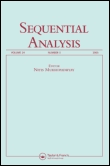
Sequential Analysis-Design Methods and Applications
Unveiling cutting-edge techniques in sequential analysis.Sequential Analysis: Design Methods and Applications, published by Taylor & Francis Inc, is a renowned journal dedicated to the advancing field of statistical analysis and design methodologies. With an ISSN of 0747-4946 and an E-ISSN of 1532-4176, this journal has been a pivotal platform for disseminating high-quality research since its inception, with coverage spanning from 1984 to 1995 and resuming its impactful presence from 2007 to 2024. The journal holds a commendable position in the academic community, categorized in the Q3 quartile for both Modeling and Simulation as well as Statistics and Probability according to the 2023 metrics. While access to articles is not open, subscriptions provide invaluable insights for researchers and professionals working on innovative statistical methods. Its Scopus rankings place it within the 33rd and 24th percentiles in Mathematics, which underscores its significant contribution to the statistical landscape. This journal is essential for those looking to stay at the forefront of statistically informed decision-making, offering a comprehensive array of articles that address contemporary challenges and methodologies in sequential analysis.

Korean Journal of Applied Statistics
Exploring New Frontiers in Applied StatisticsKorean Journal of Applied Statistics, published by the Korean Statistical Society, is a prominent journal dedicated to advancing the field of applied statistics. ISSN 1225-066X (Print) and E-ISSN 2383-5818 (Online), this journal serves as a vital platform for disseminating high-quality research that addresses the latest methodologies, applications, and innovations in statistical practices. Though currently not an open-access journal, it aims to foster collaboration among statisticians, researchers, and practitioners by providing rigorous peer-reviewed articles that enhance understanding and application of statistical techniques across various disciplines. With a commitment to integrating theory and practice, the Korean Journal of Applied Statistics stands as a crucial resource for those seeking to influence the evolving landscape of statistical research and its applications in Korea and beyond.

Electronic Journal of Applied Statistical Analysis
Advancing the Frontiers of Statistical InsightWelcome to the Electronic Journal of Applied Statistical Analysis, a pivotal platform for researchers and practitioners in the domains of Statistics and Probability, as well as Modeling and Simulation. Published by Università del Salento in Italy, this journal has been dedicated to disseminating valuable insights and advancements in applied statistical methodology since its inception in 2008. With its ISSN of 2070-5948, the journal operates within an esteemed academic framework, contributing significantly to the field despite its current Q4 ranking in both Statistics and Probability and Modeling and Simulation categories as of 2023. As we continue to explore complex statistical models and simulation techniques, the journal encourages submissions that advance theoretical and practical understandings, inviting the global academic community to engage with transformative research endeavors. For those looking to stay informed and ahead in the dynamic world of applied statistics, the Electronic Journal of Applied Statistical Analysis is an essential resource.
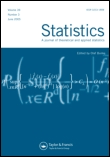
STATISTICS
Exploring the depths of statistical inquiry since 1985.STATISTICS is a distinguished journal published by Taylor & Francis Ltd, dedicated to advancing the field of statistical science since its inception in 1985. With a strong focus on both the theoretical and practical aspects of Statistics and Probability, this journal serves as a vital platform for researchers, professionals, and students seeking to disseminate their findings and contribute to critical discussions in the discipline. Although categorized in the Q3 quartile for both Statistics and Probability and Statistics, Probability and Uncertainty, the journal's commitment to quality research is evidenced by its inclusion in relevant Scopus rankings. It holds respectable positions, ranked #132/168 in Decision Sciences and #219/278 in Mathematics. By providing a venue for high-quality research articles and reviews, STATISTICS aims to foster innovation, reinforce methodological advancements, and address contemporary challenges in statistical applications. The journal does not currently offer open access, but it is widely distributed, ensuring that significant research reaches the communities that need it most. Researchers are encouraged to submit their work to this essential resource that continues to shape the landscape of statistical inquiry.
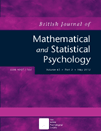
BRITISH JOURNAL OF MATHEMATICAL & STATISTICAL PSYCHOLOGY
Fostering Collaboration Across Disciplines for Enhanced UnderstandingThe British Journal of Mathematical & Statistical Psychology, published by Wiley, is a prestigious peer-reviewed journal that plays a pivotal role in advancing the interdisciplinary fields of psychology, mathematics, and statistics. With an ISSN of 0007-1102 and an E-ISSN of 2044-8317, it boasts a Category Quartile ranking of Q1 in diverse areas including Arts and Humanities, Medicine, Psychology, and Statistics and Probability as of 2023, signifying its considerable impact and relevance. This journal provides a platform for the dissemination of high-quality research and innovative methodological advancements that address complex psychological phenomena through rigorous statistical frameworks. It covers a breadth of topics from classic problems to modern data analytic techniques, appealing to researchers, professionals, and students alike. Founded in 1965, the journal continues to thrive global scholarly dialogue until 2024, fostering collaboration among disciplines and enhancing understanding of psychological data. Although it is not an open access journal, its rigorous selection process ensures that only the most significant and impactful research is published, further maintaining its esteemed position within the academic community.

Statistical Methods and Applications
Pioneering advancements in statistical methods and their applications.Statistical Methods and Applications is a leading journal published by SPRINGER HEIDELBERG, dedicated to advancing the field of statistics and its applications in various domains. With an ISSN of 1618-2510 and an E-ISSN of 1613-981X, this journal serves as a vital resource for researchers and professionals looking to explore innovative statistical methodologies and their practical implications. The journal has demonstrated a notable influence within the scholarly community, ranked Q3 in both Statistics and Probability and Statistics, Probability and Uncertainty categories as of 2023. Covering a scope that spans from its inception in 1996 to the present, Statistical Methods and Applications provides robust platforms for empirical studies, theoretical advancements, and applied statistics. Although currently not open access, the journal is well-regarded for its rigorous peer-review process and commitment to high-quality research, making it an essential read for anyone dedicated to enhancing their statistical knowledge and expertise.
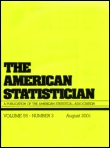
AMERICAN STATISTICIAN
Advancing statistical science for a brighter tomorrow.AMERICAN STATISTICIAN is a premier journal publishing high-quality research, reviews, and methodologies in the fields of statistics and mathematics. Established in 1947 and published by Taylor & Francis Inc, this esteemed journal holds an impressive Q1 ranking in Mathematics and Q2 rankings in Statistics and Probability, showcasing its significant influence within the academic community. With a substantial readership among researchers, educators, and professionals, the journal serves as a critical platform for advancing statistical science and providing innovative techniques that influence a range of disciplines. Though the journal does not operate under an open access model, it remains highly regarded, reflecting its robust editorial standards and commitment to fostering scholarly communication. Those seeking to contribute to or stay abreast of cutting-edge statistical developments will find the AMERICAN STATISTICIAN an essential resource for their academic and practical pursuits.
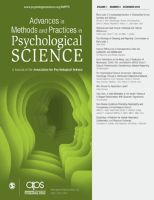
Advances in Methods and Practices in Psychological Science
Discovering Tomorrow's Practices in Psychological Science Today.Advances in Methods and Practices in Psychological Science is an esteemed journal dedicated to the advancement of innovative methodologies and practices within the field of psychology. Published by SAGE Publications Inc, this journal offers a prominent platform for researchers, professionals, and students to explore and disseminate significant contributions to psychological methods, emphasizing contemporary practices that improve research quality and applicability. With an impressive impact factor reflected by its Q1 quartile ranking in the field and a prestigious Scopus rank of #5 out of 216, positioning it in the top 3% of journals in general psychology, this journal stands as a critical resource for anyone engaged in psychological research. Operating within the open access framework, it ensures that cutting-edge findings are readily available to a global audience, thereby fostering collaboration and discussion. With a publication timeline spanning from 2018 to 2024, it continues to be at the forefront of psychological scholarship, championing the use of modern techniques and practices that reflect the evolving landscape of the discipline.
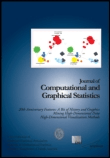
JOURNAL OF COMPUTATIONAL AND GRAPHICAL STATISTICS
Empowering scholars with cutting-edge insights in statistics.JOURNAL OF COMPUTATIONAL AND GRAPHICAL STATISTICS is a premier academic publication dedicated to advancing the fields of computational statistics and graphical data representation. Published by Taylor & Francis Inc, this journal stands out with its impressive Q1 rankings in Discrete Mathematics and Combinatorics, Statistics and Probability, and Statistics, Probability and Uncertainty, reflecting its high impact and relevance in contemporary research. Since its inception in 1992, the journal has been a vital resource for researchers, professionals, and students alike, with its rigorous peer-reviewed articles contributing significantly to the science of data analysis and visualization. With a Scopus ranking placing it within the top tiers of its category, the journal is committed to disseminating high-quality research that promotes innovation and methodological advancement. Note that the journal currently follows a traditional subscription model, ensuring focused and curated content for its readers. As it approaches the horizon of 2024, the JOURNAL OF COMPUTATIONAL AND GRAPHICAL STATISTICS continues to foster scholarly discourse and discoveries, making it an essential platform for anyone involved in statistics and data science.